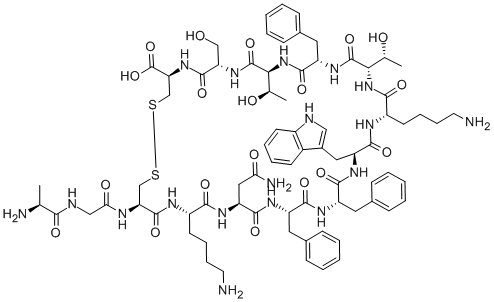Somatostatin , ≥95% , 51110-01-1
Synonym(s):
Growth hormone release inhibiting factor;Somatostatin-14;Somatotropin release inhibiting factor;SRIF
CAS NO.:51110-01-1
Empirical Formula: C76H104N18O19S2
Molecular Weight: 1637.88
MDL number: MFCD00076762
EINECS: 256-969-7
| Pack Size | Price | Stock | Quantity |
| 1mg | RMB408.00 | In Stock |
|
| 5mg | RMB1519.20 | In Stock |
|
| 25mg | RMB3199.20 | In Stock |
|
| 100mg | RMB5599.20 | In Stock |
|
| others | Enquire |
PRODUCT Properties
| storage temp. | −20°C |
| solubility | H2O: 1 mg/mL |
| form | powder |
| Water Solubility | Soluble in water (0.3 mg/ml) |
Description and Uses
Originally isolated from hypothalamic tissue, somatostatin is characterized as an inhibitor of growth hormone (GH) release. The structure was determined in 1971. Subsequent investigations led to the recognition that somatostatin also was released from the pancreas and has a role of inhibiting the secretion of both insulin and glucagon. A total of five somatostatin receptor subtypes have been characterized and cloned (sst1 to sst5). Subtype sst4 is associated with the inhibition of insulin release, and an sst4-selective inhibitor has been reported. The somatostatin analogue SOM230 has exhibited selectivity for sst1, sst2, sst3, and sst5 in rats and effectively decreased plasma GH and insulin-like growth factor-1 (IGF-1) levels by 75% without significant effects on insulin or glucagon. Another analogue, PT R3173, with selectivity for recombinant human somatostatin receptor (hsst2, hsst4, hsst5) was substantially more effective in inhibiting GH secretion compared to glucagon and insulin release in rats.
Somatostatin is a peptide hormone that regulates the endocrine system. Extensive SS analogs with improved pharmacokinetics, bioavailability, and receptor subtype selectivity have been developed. These include nonpeptidergic analogs and octapeptides such as octreotide and lanreotide. Octreotide and lanreotide are long-acting sst2-preferring agonists, and are used for the treatment of acromegaly, gastroenteropancreatic tumors, neuroendocrine tumors, and other gastrointestinal disorders such as secretory diarrhea and gastrointestinal bleeding.




